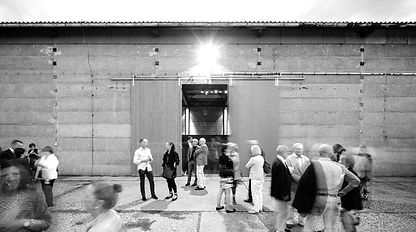

Dimitri Shostakovich, June 1960



Three Days (2022)
-A performance for four contemporary dancers and string quartet
Artistic concept
Three Days is a collaboration between contemporary dance company Raekallio Corp. and the Borodin Quartet, one of the world's most acclaimed classical string quartets. The two-part work is set to a live performance of Dmitri Shostakovich's String Quartet no. 8 (1960), which is widely regarded as an essential part of the 20th-century chamber music literature.
Taking as its starting point the musical structures as well as the political and personal overtones of Shostakovich's composition, Three Days reflects and reinterprets the mid-20th century social climate represented by the music from the perspective of the 2020s. Which fears and questions are still relevant, and which are resurfacing in new forms? As we outgrow the early years of the fourth industrial revolution, we find ourselves balanced between the realistic hope of solving our global problems, and an existential horror of the future we are collectively creating for ourselves.
The four dancers of the piece are longtime collaborators of Valtteri Raekallio, all renowned as individual, virtuosic perfomers. The movement language of the piece is a starkly physical expression of the affective dimensions of societal power, individual agency and the naked fragility of our shared humanity.
Background on the work
Dimitri Shostakovich's String Quartet No. 8 in C minor, Op. 110 was written in a remarkably short time over a period of three days in July 1960. At the time, Shostakovich was residing at a hotel in East Germany and was supposed to be writing film music. However, because of recent, traumatic events concerning his health and his relation to the Soviet authorities, he instead composed this famous and controversial quartet.
The so-called hidden messages in Shostakovich's music have been widely debated, and the discussion will likely continue for many decades still. In this project, we do not seek to find any final answers, but we explore the music itself with the inspiration of sources that might give some clues. Could it be that we hear the knock on the door by Stalin's men in the music in the fourth movement? Or is the cello solo, when the whole quartet is almost making a delirious or foggy sound, the mind drifting off when conscience is lost from lack of oxygen?
Production plan
As an artistic and creative challenge, the dance company and string quartet will work together in rehearsal for the same time frame that Shostakovich spent: Three days. The main choreographic work of the piece will be done in Helsinki in June 2021. The on-site collaborative part of the project will take place in Gohrisch, the same town where Shostakovich composed the piece.
The 11th International Schostakowitsch-Tage festival is held in Gohrisch from July 2nd to 5th 2021, and the project is realized as a commissioned work by the festival. Audiences will have a chance to follow the creation of the work in open rehearsals, and the production will be presented as the closing performance of the festival on July 5th. The performance will be presented in the main festival venue with an audience capacity of 500 people.
The piece and its process will also be filmed and made into a documentary by Peiling Film & TV (Norway) and Lumikinos Production (Finland). The documentary will be presented by multiple European broadcasters from 2022 onwards.
Later on, the show will also be performed in Finland. At the moment, we are negotiating with Dance House Helsinki. We are also planning a tour with this production in Europe.
Schedule
April-May 2021
Preproduction in Helsinki, Finland and Gohrisch, Germany
June 2021
Rehearsals for dancers in Helsinki, Finland
3.–5.7.2021
Ensemble rehearsals and festival performance at International Schostakowitsch-Tage Gohrisch Festival.
Working group
Artistic concept and choreography: Valtteri Raekallio
Music: Dimitri Shostakovich / Borodin Quartet (musicians)
Dancers: Annamari Keskinen, Mirva Mäkinen, Ryan Mason and Eero Vesterinen
Set design: Aino Koski
Lighting design: Lauri Lundahl
Video projections: Thomas Freundlich
Partners
Raekallio Corp. (FI)
Raekallio Corp. is an independent dance company based in Helsinki, Finland, presenting the work of choreographer/director Valtteri Raekallio. The company produces Raekallio’s immersive site-specific works, as well as stage productions designed for international touring and dance film projects. Raekallio's recent touring works include Recollections (2019), Oneiron (2018), A Performance (2016) and Rehearsal on Love (2015). The company was awarded the Finland Prize in 2019. www.raekallio.fi
Borodin Quartet (RU)
The Borodin Quartet is a string quartet founded in 1945 in the Soviet Union. It is one of the world's longest-lasting string quartets, having marked its 70th anniversary season in 2015. The Quartet’s connection with Shostakovich’s chamber music is intensely personal, since it was stimulated by a close relationship with the composer, who personally supervised its study of each of his quartets. Widely regarded as definitive interpretations, the Quartet’s cycles of the complete Shostakovich’s quartets have been performed all over the world, including Vienna, Zurich, Frankfurt, Madrid, Lisbon, Seville, London, Paris and New York.
Schostakowitsch-Tage Gohrisch (DE)
Since its founding in 2010 the International Shostakovich Festival Gohrisch has established itself as a foremost chamber music festival in Europe, dedicated to the music of Russian composer Dmitri Shostakovich. Many prominent artists have performed in Gohrisch so far: violinist Gidon Kremer, and his Kremerata Baltica, pianists Igor Levit and Anna Vinnitskaya, cellist Natalia Guttman, singer Andreas Scholl, conductors Michail and Vladimir Jurowski.